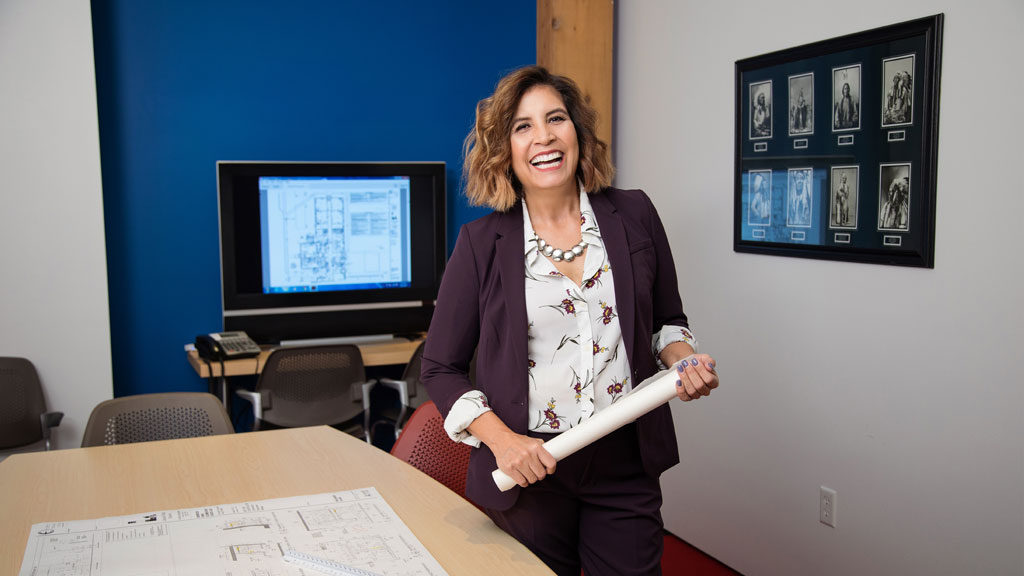Award honors those who exemplify the profession’s proactive social mandate
Washington, D.C. – December 6, 2017 – The Board of Directors and the Strategic Council of the American Institute of Architects (AIA) selected Tamara Eagle Bull, FAIA, to receive the 2018 Whitney M. Young Jr. Award. Eagle Bull is an advocate for culturally relevant and responsible design, and a recognized leader in the realm of contemporary Native American architecture. As the first Native American woman in the U.S. to become a licensed architect, she uses her position and knowledge to improve the schools and communities in which she works.

Tamara Eagle Bull, FAIA. Photo credit: © Encompass Architects, p.c.
A member of the Oglala Lakota Nation, Eagle Bull channels her 30 years of experience through Encompass Architects, her Lincoln, Nebraska, firm. Having faced racism on her journey to firm ownership, she works to rectify a built environment in which Native Americans have had little say, and where functionality is often compromised by generic pan-Indian motifs. In addition to its important work with tribal clients, Encompass Architects has helped reshape Lincoln’s urban fabric through several significant commercial projects.
“When I hear her tell the story of place, of how place formed her perspective on architecture, it reminds me of Native Peoples’ distinct connection to Mother Earth,” wrote Michael Laverdure, AIA, president of the American Indian Council of Architects and Engineers, in a letter supporting Eagle Bull’s nomination for the Whitney M. Young Jr. Award. “She has been an advocate for Native American communities, while working in those communities. Simply by listening and designing with her Tribal clients instead of for them, she is doing a great service to society.”

Tamara Eagle Bull, FAIA. Photo credit: © Encompass Architects, p.c.
Eagle Bull’s sensitivity is evident in projects such as the Gila River Indian Community Governance Center in Sacaton, Arizona. Envisioned as the embodiment of tribal sovereignty, it expressed strength and independence, its landscape design and details depicting the culture of the Pima and Maricopa peoples in an elegant manner. In South Dakota, Eagle Bull developed three concepts for the Oglala Sioux Tribe to create a new memorial at the site of the Wounded Knee Massacre. The sacred site currently has no memorial, merely a sign that is often vandalized or stolen and a nearby museum operated by a non-tribal member. Three schemes were presented to community groups, and the project is currently exploring funding options to finance next phase.

Tamara Eagle Bull, FAIA. Photo credit: © Encompass Architects, p.c.
Eager to meet like-minded design professionals, Eagle Bull became active with the American Indian Council of Architects and Engineers shortly after graduation from the University of Minnesota School of Architecture. She led the way for changes in the organization and transitioned it from a small gathering of Native American firm-owners to an organization that welcomes architects and engineers at all career levels. As the council’s executive board secretary, Eagle Bull was instrumental in negotiating a memorandum of understanding with the National Organization of Minority Architects that allows the two organizations to work together for mutual benefit.
Established in 1972, the Whitney M. Young Jr. Award honors architects and organizations that champion a range of social issues, including affordable housing, minority inclusion and access for persons with disabilities. The award is named after the civil rights–era head of the Urban League who confronted — head-on — the AIA’s absence of socially progressive advocacy at the 1968 AIA National Convention. Eagle Bull will be honored at the AIA Conference on Architecture 2018 in New York City.
About The American Institute of Architects
Founded in 1857, The American Institute of Architects consistently works to create more valuable, healthy, secure, and sustainable buildings, neighborhoods, and communities. Through nearly 300 state and local chapters, AIA advocates for public policies that promote economic vitality and public wellbeing. Members adhere to a code of ethics and conduct to ensure the highest professional standards. AIA provides members with tools and resources to assist them in their careers and business as well as engaging civic and government leaders and the public to find solutions to pressing issues facing our communities, institutions, nation and world.
Editor’s Note
Read Detroit Collaborative Design Center honored with the 2017 Whitney M. Young Jr. Award


